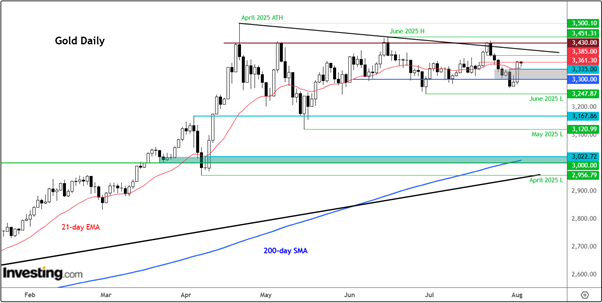In the wake of a significant resurgence on Friday, the market has witnessed a slight deceleration in momentum, though it continues to enjoy support amid ongoing discussions suggesting that both the bond yields and the market itself could be nearing a short-term peak. This notion wasn’t aided by the dismissal of the Bureau of Labor Statistics (BLS) head, following accusations from President Trump that the agency was meddling politically with data. Meanwhile, the unexpected early departure of Fed Governor Adriana Kugler, who was slated to serve until January, opens up an opportunity that could potentially shape the Federal Reserve’s direction, extending beyond the forthcoming September meeting.
As the new week began, there was a noticeable improvement in risk appetite, reflected through stronger performances in European stocks and futures. This partial recovery is an attempt to regain confidence shaken by Friday’s underwhelming data, which had precipitated a drop. Despite the Swiss franc and yen not making significant strides, it appears that gold may struggle to capitalize fully on the momentum gathered on Friday. As it stands, those betting against gold are on the lookout for a new catalyst that could reintroduce pressure, reminiscent of the previous week’s dynamics.
Looking ahead, the immediate attention concerning the US dollar seems centred on the dovish implications brought about by Governor Kugler’s unexpected resignation and the rather abrupt termination of the BLS chief. In terms of economic data, the market awaits US factory orders expected later today, with consumer credit data on the horizon for Tuesday and jobless claims data anticipated on Thursday.
On the European front, the Sentix Investor Confidence index outcome was notably weaker than expected, recording a fall to -3.7 against a forecasted +6.2. This significant deviation underscores the fact that optimism within the eurozone remains uneven at best. Given the relatively light schedule on the macroeconomic calendar this week, attention is likely to pivot towards commentary from Federal Reserve officials and updates on trade negotiations.
The resilience of gold during this period, especially following the EU-US trade agreement that aimed to stave off a major trade war, underscores investor caution regarding the broader implications of the tariffs deal for the global economy. Notably, the imposition of higher tariffs on some countries, such as Switzerland, adds another layer of complexity to this narrative. Although an all-out trade war seems to have been averted for the moment, it remains challenging to ascertain the full impact on the demand for gold as a safe-haven asset. Despite gold’s impressive rally in recent months, the search for a new significant driver to propel prices to new heights beyond the April record of $3,500 continues.
As we progress deeper into the latter half of 2025, the robust uptrend seen in gold will likely face a test, with the velocity of future gains expected to moderate. With the long-term price charts indicating an overbought condition, a period of consolidation seems both pragmatic and inevitable. Furthermore, a correction, while maybe surprising to some, would align with the revival in risk appetite, underscored by recent record highs in US and European stock indices.
In a more technical perspective, gold’s performance following Friday’s notable uptick demonstrates a break through several resistance levels, reclaiming position above the 21-day exponential moving average. This shift has somewhat diluted the bearish sentiment following the breach below the $3,300 mark seen the past week. For bears to reassert dominance, a pullback below this pivotal level is necessary in the days ahead. Looking from a bullish standpoint, gold has already encountered its initial upside target at $3,360, with potential resistance looming around the $3,385 mark, followed closely by the $3,400 threshold where a bearish trendline emerges.
Expanding our view to the longer-term horizon, the monthly chart continues to present a picture of strength for gold, despite observing some hesitancy in price action at elevated levels in recent months. This is illustrated by the formation of doji candles, signifying a stalemate between buyers and sellers, and perhaps hinting at exhaustion following the sustained rally leading to record highs.
Given this backdrop, the long-term indicators such as the monthly Relative Strength Index (RSI), which has hovered in the ‘overbought’ domain since April 2024, signal caution with even more extreme readings attained this summer. Historically, such elevated RSI levels have often preceded phases of consolidation or correction. However, it is imperative to remember that as long as the underlying market sentiment remains upbeat, the impact of the RSI alone might be limited.
Moving forward, market participants who might have felt sidelined during the rally would likely prefer a substantial correction which could provide more appealing entry points. Despite the emergence of potential exhaustion signals, the long-term outlook for gold remains bullish absent any significant markers of reversal. The journey ahead for gold prices hinges on whether the market can sustain its bullish vigour amidst warnings of possible consolidation or a downward correction necessitated by the need to alleviate overbought conditions.
This synopsis is intended solely for informational purposes and does not aim to offer investment advice or endorse asset purchases. It is crucial for investors to assess risks from multiple angles since investments can be highly volatile. Decision-making and associated risks lie solely with the investor.



